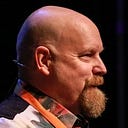Helping Geeks Feel Safe in the World
I’m Kent Beck & my mission is to help geeks feel safe in the world.
Help. I can’t make anyone else feel anything but I can help.
Geeks. I speak first to people like me, geeks, who care about mechanisms & puzzles & surprising ideas.
Feel. Living in my head most of the time divorced me from my emotions, which came back to bite me later. Hard. So I talk about emotions but also ideas from the perspective of how they affect & are affected by feelings.
Safe. I often feel unsafe in situations where I’m perfectly safe, like a cocktail party. Sometimes I feel safe in situations where I’m acting unsafe, like pushing code that will break the system. I want my feelings of safety (or unsafety) to match the facts.
In the world. Yes I talk about programming & software development, but I have learned my skills in the world at large contribute to my geeky pursuits & my geeky skills can contribute to the rest of my life.
How Did I Discover My Mission?
I looked at the things I had done in the first 2 decades of my career & asked what in the world tied together patterns, JUnit, TDD, & Extreme Programming? The phrase, helping geeks feel safe in the world, popped into my head.
At first I thought what in the world does that mean? Then I realized that feeling safe when I was actually safe was a desperate wish of mine. I was beset by anxiety at the time. Each of the projects above increased safety:
Patterns—Design discussions that are more likely to result in shared understanding & agreement.
JUnit—Does this code work? The answer is a button press away. (I used to press the button 2 or 3 times if I really needed reassurance.)
TDD—Do I know what the code is supposed to do? If I’m under time pressure, how will I know the code works?
Extreme Programming—A whole set of safety-enhanced personal interactions.
Why A Newsletter with Paying Subscribers?
I needed new incentives. I started working actively on software design in 2005, although my interest went back to the 80s. You’ll notice that’s quite a while ago. I just wasn’t writing. What’s going to get me over my inertia?
Turns out, the answer is “$25/month”. When I see a new subscriber, I want to deliver them something worthwhile. When I lose a subscriber, oh my, I want to deliver something valuable.
With paying subscribers I don’t take my readers’ interest for granted. This leads me to take my responsibility to communicate more seriously.
I expected a few friends-and-family to sign up. That would have been enough to keep me writing. I was shocked to discover that paying subscribers could actually free up my time to think & write more. And the ceiling is much higher—paying subscribers potentially could fund my retirement. But I’m going to need to keep creating value for that to happen.
Why subscribe?
I asked this question when I got to hundreds of paying subscribers. The answers clustered around:
Gratitude for ideas I’ve contributed to in the past.
Gratitude & encouragement for the ideas I’m working on now.
With the help of a business coach, I acknowledged just how much gratitude I feel for the freedom my paying subscribers afford me. In return, I began publishing Thinkies, habits of creative thought. You’ll get one every Tuesday.
Thinkies resulted from my introspection on ideas of mine that other people label “creative”. I noticed that most of my ideas result from identifiable habits of thinking, not from some mysterious tap on the forehead from a Muse.
Ordinarily I wouldn’t publish a project this early, but I wanted to express my gratitude to my paying subscribers. I began publishing something unique. I like the idea that I can identify the first thousand people to hear about one of my ideas. The conversation around each Thinkie has been amazing.
The other content for paying subscribers is fully drafted chapters from my books on software design. Since the first book is done & I haven’t started the second, there aren’t any of these at the moment.
Join the crew
Be part of a community of people who care about the hard questions of software design:
When?
Why?
How much?
Who?
And most importantly:
How’s that feel?
To find out more about the author visit KentBeck.com.


